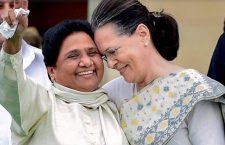Politics and religion, that ultimate heady mix plays out in all its suspect glory this Kumbh mela
It’s a surreal sight, and yet in a state that has been on a renaming overdrive in a bid to erase those parts of history not considered nationalistic enough, it is perhaps the very image of a new culture embodied.Approximately 200 warm bodies set off from various parts of Bundelkhand, in what is essentially a state-sponsored caravan to the ongoing Kumbh Mela in erstwhile Allahabad, or Prayagraj.
The procession we’re reporting on is similar to many others across the state and country journeying towards Pragyaraj in Uttar Pradesh for a cleansing dip in the holy rivers of Ganga and Yamuna; after all, the total number of visitors this year is estimated at a whopping 150 crores. “We left the Ashram on 19th December, there are 200 of us,” said devotee Pashuram, who left his home in the district of Vidhisha in Madhya Pradesh to travel hundreds of kilometers for this year’s Kumbh Mela, a 55-day festival, touted as the ‘biggest peaceful religious gathering in the world’, which started off on January 15 and concludes on March 4. “All the devotees try to reach Kumbh before the designated days,” said Nageshwar from Chitrakoot who was also part of the procession.
What might be unique, however, to this caravan is that it is funded, unofficially, by official sources – it is the culmination of a month spent in the badlands, where everyone from local health workers to reporters had been repeatedly wooed by government officials, casually of course, to join them on a trip. “Including travel and food expenses, we need a total of 6-8 lakhs,” said Pashuram, who was also heading his procession and thus in-charge of everyone’s food and stay provisions, “And for our stay in Kumbh, it will cost extra.”
It seems to be a quick case of do the Math and politicking in a state that has set aside a budget of Rs. 4200 crores, three times that of the 2013 Mela. The UP government and the city of Pragyaraj have after all been prepping for the Kumbh, much like the faithful, including those treating the journey as a junket. Roads have widened, encroachments razed, dividers constructed, and half a dozen flyovers have been built in the city. 6000 state buses have been deployed to ferry pilgrims to and from Kumbh. 800 special trains are running to Pragyaraj to make it more accessible to those who’d like to attend. Massive accommodations for stay, beyond just the basic facilities and makeshift tents of past editions, have been erected on Mela grounds. All of it spearheaded and massively pushed by Chief Minister Yogi Adityanath and his administration. “Saab aaj duty par nahi hai, snaan ke liye gaye hai (The officer is not at work today, he’s gone for the ritual bath)”, is a common enough excuse/line we hear these days, even at the district level, as wescramble for official bytes.
Not that it should shock or surprise, given how all the important party leaders who have made and/or are making a beeline for Kumbh, including the President of India – a first in Kumbh history.With larger than life posters of PM Modi’s smiling face, helpfully complemented with information about flagship BJPcampaigns, it is clear that this year’s Kumbh Mela is laden with clear political intent and import.
Something that was evident to Devdas, a saint who had previously attended Kumbhs in Pragyaraj, Nasik, Haridwar and Ujjain. “The government must play a role in all kumbhs,” he explained, “but with this I can see that this government is far more involved.”
Adityanath’s government has relentlessly advertised the Mela, especially to NRIs. Both P.M. Narendra Modi and C.M. Adityanath have waxed poetic about the holy dip in the lead-up to January 15. With a push to provide luxury, hotel-like accommodation, experience packages and tours, the attempts to please and coax economically well-off are no secret. With the 2019 elections mere months away, a commitment to making Kumbh larger than life seems to be an attempt to secure votes from the Hindu belt too.
As for the renaming exercise? The mela itself hasn’t been spared, it would appear. As Pashuram explained, “Actually, this is the Ardhkumbh, which is organized every six years. The main Kumbh Mela only comes once every 13 years. But as per Yogiji’sorders, Ardhkumbh has been renamed Kumbh and the larger one will now be called Mahakumbh.” But why so, we ask. “No comments”, said Pashuram, urging the caravan to move on after a long break.
Onwards, Prayagraj!
This Khabar Lahariya article first appeared on Firstpost.

